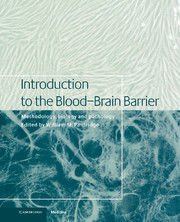Book contents
- Frontmatter
- Contents
- List of contributors
- 1 Blood–brain barrier methodology and biology
- Part I Methodology
- Part II Transport biology
- 18 Biology of the blood–brain glucose transporter
- 19 Glucose transporters in mammalian brain development
- 20 Blood–brain barrier amino acid transport
- 21 P-glycoprotein, a guardian of the brain
- 22 Blood–brain barrier ion transport
- 23 Ion channels in endothelial cells
- 24 Interactions of lipoproteins with the blood–brain barrier
- 25 Fatty acid and lipid intermediate transport
- 26 Blood–brain barrier transport of drugs
- Part III General aspects of CNS transport
- Part IV Signal transduction/biochemical aspects
- Part V Pathophysiology in disease states
- Index
19 - Glucose transporters in mammalian brain development
from Part II - Transport biology
Published online by Cambridge University Press: 10 December 2009
- Frontmatter
- Contents
- List of contributors
- 1 Blood–brain barrier methodology and biology
- Part I Methodology
- Part II Transport biology
- 18 Biology of the blood–brain glucose transporter
- 19 Glucose transporters in mammalian brain development
- 20 Blood–brain barrier amino acid transport
- 21 P-glycoprotein, a guardian of the brain
- 22 Blood–brain barrier ion transport
- 23 Ion channels in endothelial cells
- 24 Interactions of lipoproteins with the blood–brain barrier
- 25 Fatty acid and lipid intermediate transport
- 26 Blood–brain barrier transport of drugs
- Part III General aspects of CNS transport
- Part IV Signal transduction/biochemical aspects
- Part V Pathophysiology in disease states
- Index
Summary
Introduction
The uptake of glucose into mammalian cells is a necessity, and, regardless of the cell type, occurs either by facilitative diffusion along a natural glucose concentration gradient or by an active sodiumcoupled transport system against the glucose concentration gradient. During the past decade, the molecular structure, function and location of glucose transporters (GTs) has been extensively studied, leading to a rather detailed knowledge of the mechanisms underlying sugar transport in biological tissues (for review see Bell et al., 1990; Kasanicki and Pilch 1990; Thorens et al., 1990; Bell et al., 1993; Partridge and Boado, 1993).
Collectively, the sodium-independent ‘facilitative’ glucose transporters form a small multigene family of structurally and functionally related integral transmembrane proteins. Despite their close relationship, facilitative GTs exhibit distinct kinetic properties and show a pronounced tissue-specific expression pattern. To date, seven members of the facilitative GT family have been described and their cDNAs have been cloned and sequenced. These sequences, including one non-functional pseudosequence (Glut 6) (Kayano et al., 1990), were termed Glut 1 to Glut 7, referring to the order in which they were identified.
This chapter focuses on the developmental expression of the major facilitative glucose transporters in the mammalian brain. Facilitative GTs of tissues other than the brain are not discussed further.
- Type
- Chapter
- Information
- Introduction to the Blood-Brain BarrierMethodology, Biology and Pathology, pp. 175 - 187Publisher: Cambridge University PressPrint publication year: 1998
- 2
- Cited by

